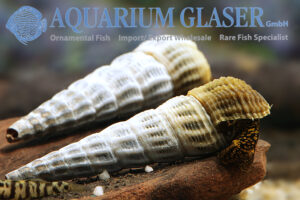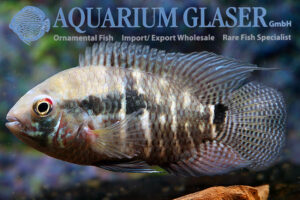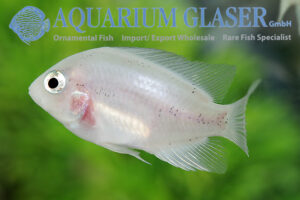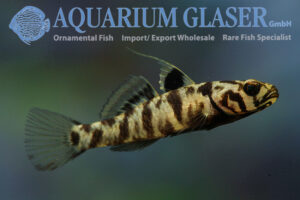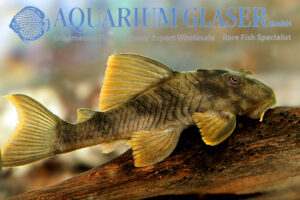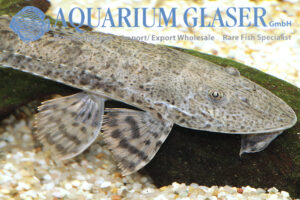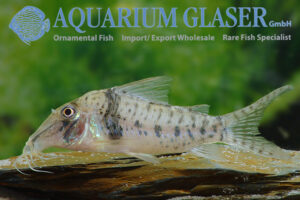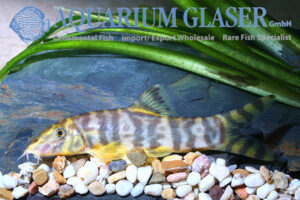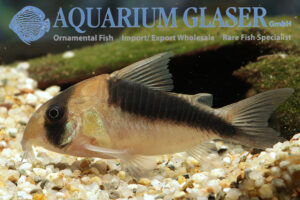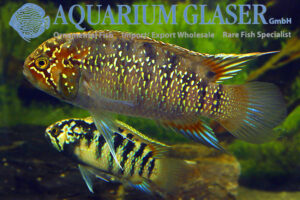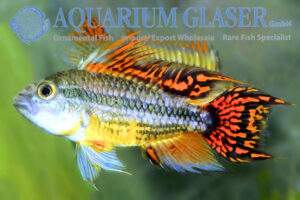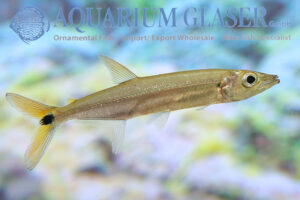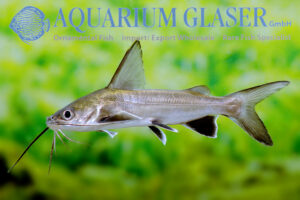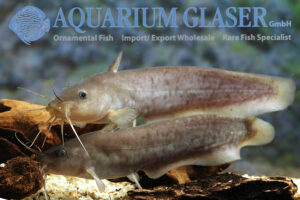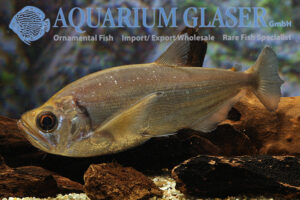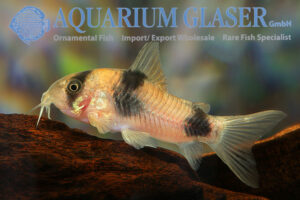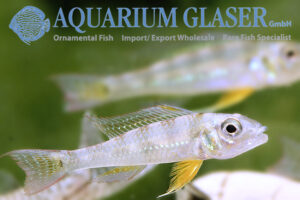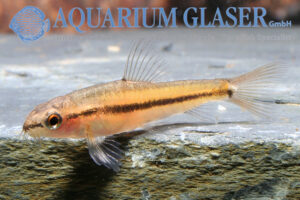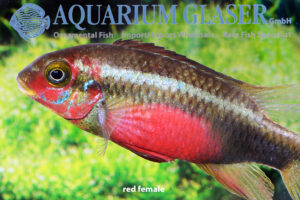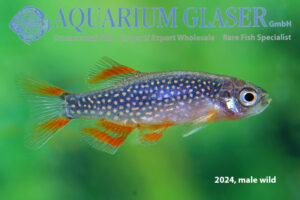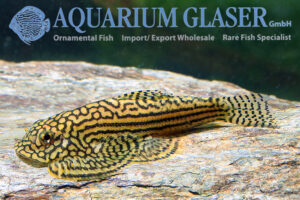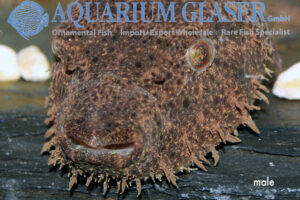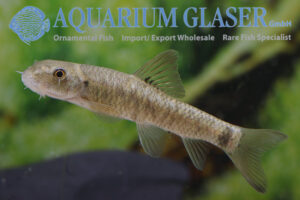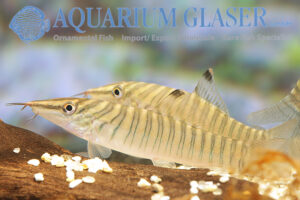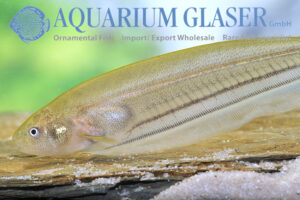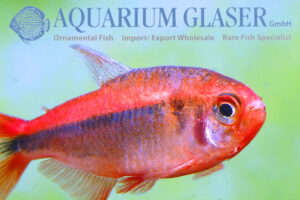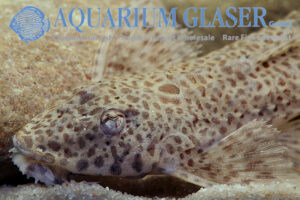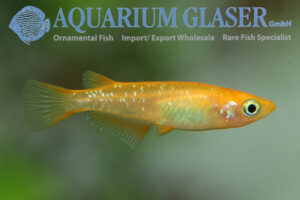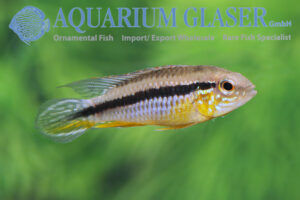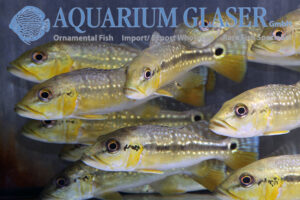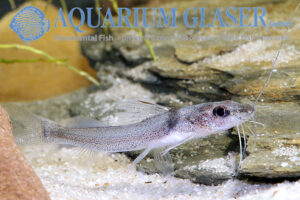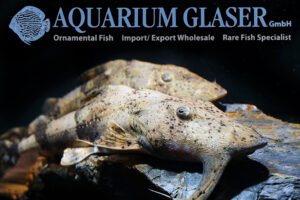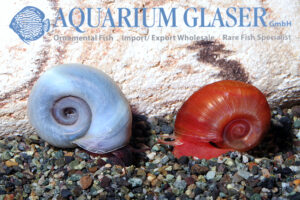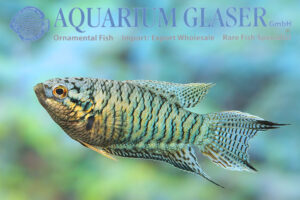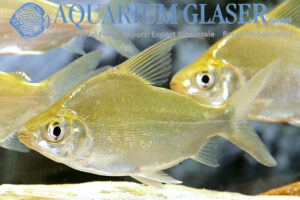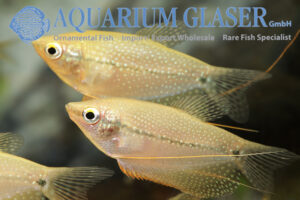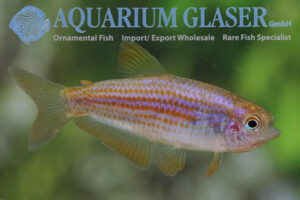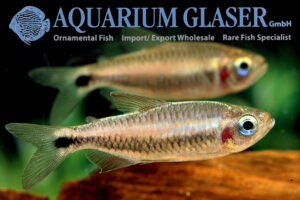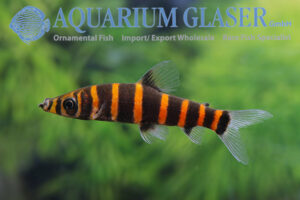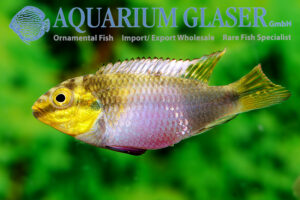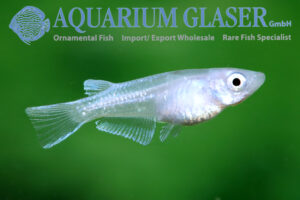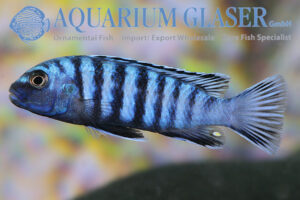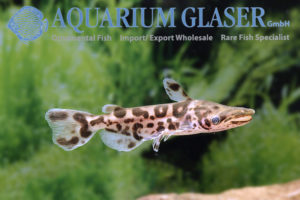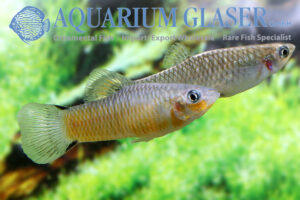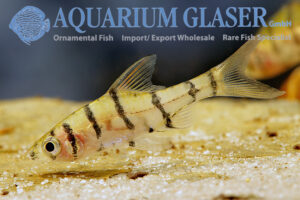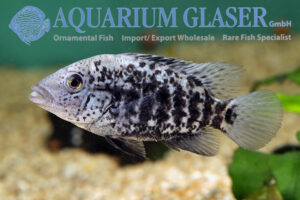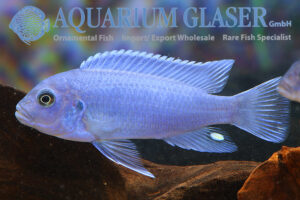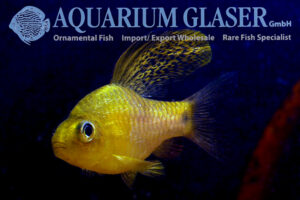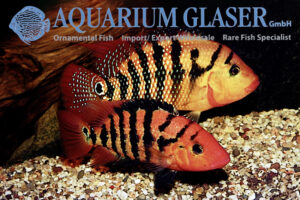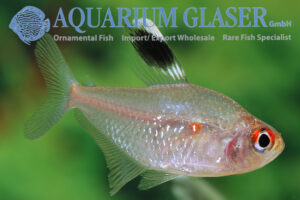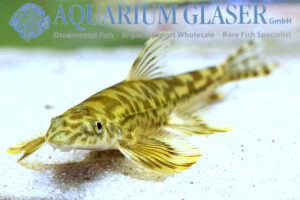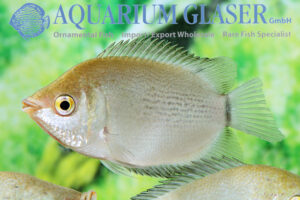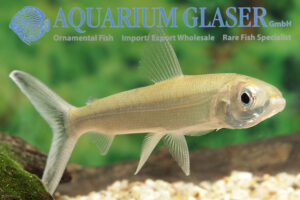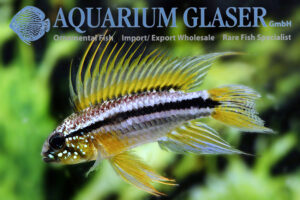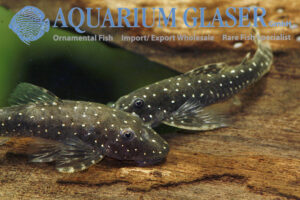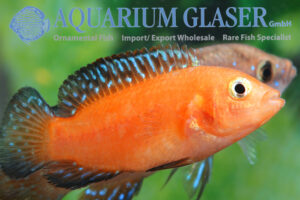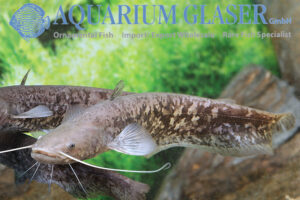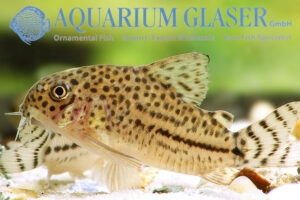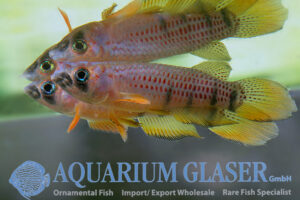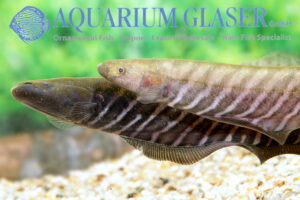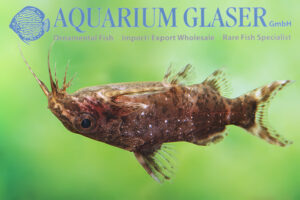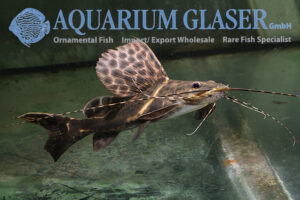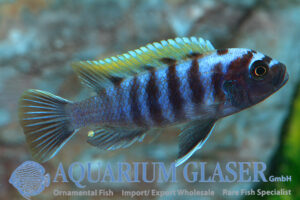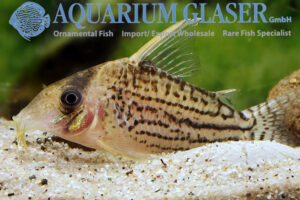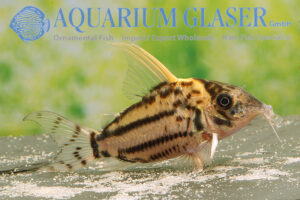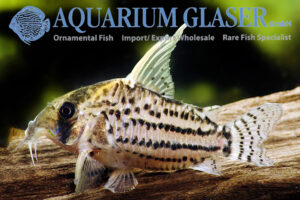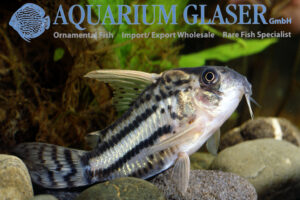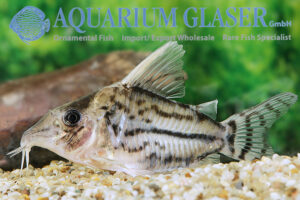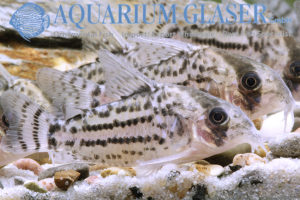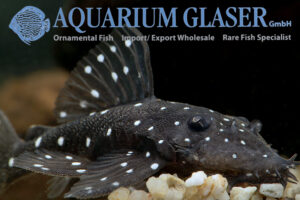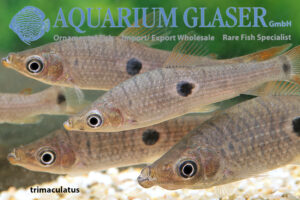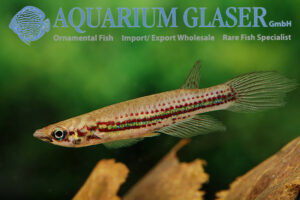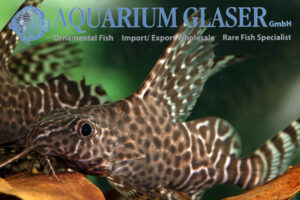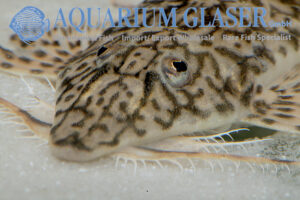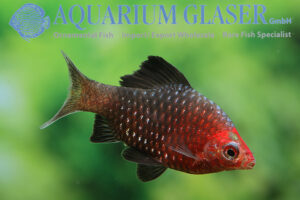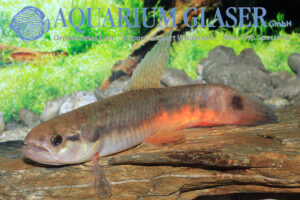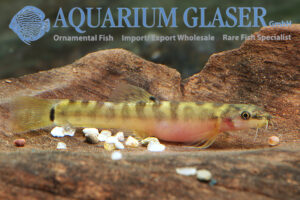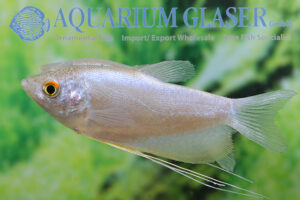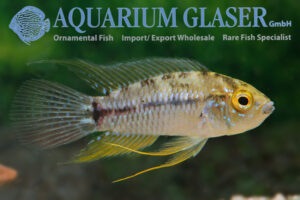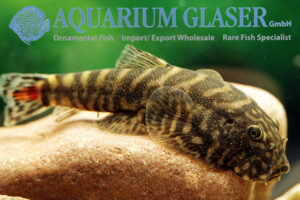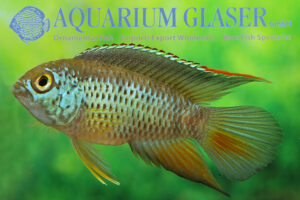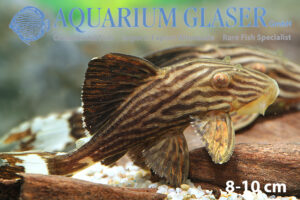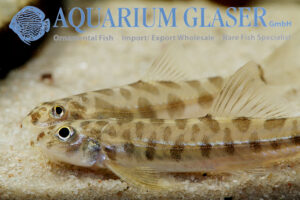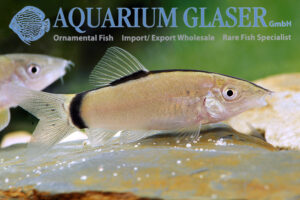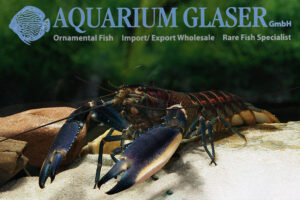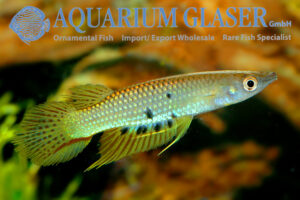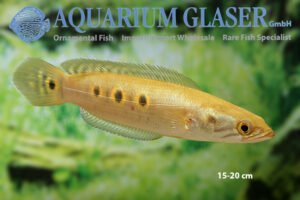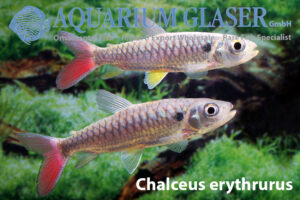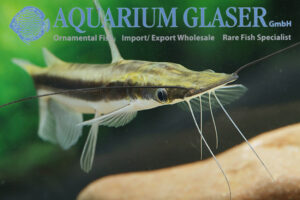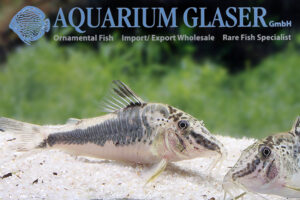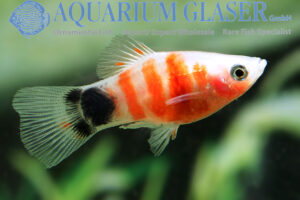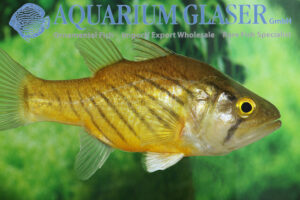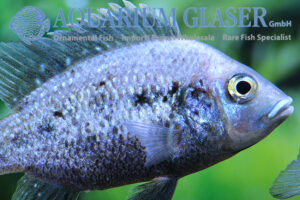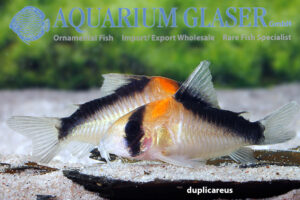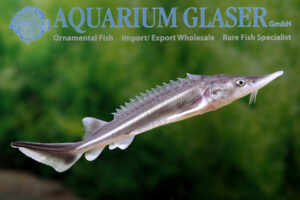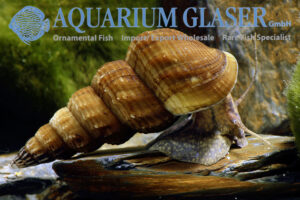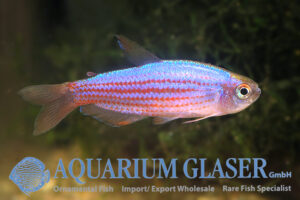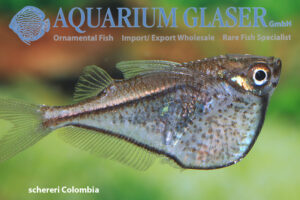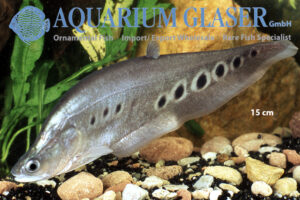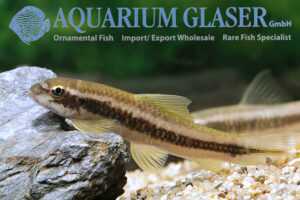Although in aquaristics the scientific names are usually chosen for communication and only very few species have a really common or international popular name, there seems to be an occasional need for such popular names. However, in the case of the snail Tylomelania marwotoae, which originates from a single lake on Sulawesi – Lake Mahalona, […]
Fish Archive (3076)
-
-
Cichlasoma pusillum
Cichlids identified as Aequidens portalegrensis have been kept and bred in the aquarium since 1913. The German common name was “Streifenbuntbarsch” ( = striped cichlid) because the fish can show numerous vertical stripes in the rear half of the body. As there is a very nice photo by Paul Unger from the 1930s of a […]
-
Vieja fenestrata White & Marbled
The Central American large cichlids of the genus Vieja (synonym: Paratheraps) were, like so many others, previously classified as Cichlasoma. In the 1980s and 1990s, these fish enjoyed relatively great popularity among cichlid enthusiasts who traveled to their Central American habitats and brought back many new findings (and a few little fish). The species Vieja […]
-
Mugilogobius adeia
This strikingly beautiful dwarf goby, which is endemic to Lake Matano on Sulawesi (formerly Celebes), was only scientifically described in 1992, although this lake has long been known as the focus of independent evolution and has been the subject of much research. The earliest findings probably date back to 1989, when Arthur Werner and Maurice […]
-
Peckoltia sp. L76
In 1990, well over 30 years ago, the beautiful orange-fringed loricariid catfish L76 was introduced in the DATZ. Like L99, which was introduced in 1992 and is currently only seen as a color variant of L76, it originates from the Brazilian state of Pará, more precisely from the Rio do Pará. There are three forms […]
-
Loricariichthys sp. Rio Blanco
The interesting genus Loricariichthys currently comprises 19 accepted species. The members of the genus can be reliably recognized by the shape of their lips. These lip-brooding catfishes – similar to many other whiptail catfishes, the male carries the clutch of eggs attached to the lower lip until the larvae hatch – do not have any […]
-
Corydoras orcesi
The beautifully marked Corydoras orcesi is only very rarely found in the aquariums of enthusiasts. The species has been described from the Rio Tigre system in Ecuador, originally as a subspecies of C. pastazensis. Both species are similarly colored, but no hybrid forms occur, so that they are in all probability independent species, even if […]
-
Botia udomritthiruji
From time to time you have to tidy up the homepage a bit. On one such occasion we came across this nice post from 2007: Botia sp. New Emperor, probably imported for the first time, comes from the border region of Burma/Thailand. It is said to occur there in large numbers every ten years and […]
-
Hoplisoma sp. CW 91/CW 107
The Rio Vaupés – the Spanish spelling – or Rio Uaupes – the Portuguese spelling – is a “small” right-bank tributary of the Rio Negro. After all, the “little one” has a length of 1,375 km! It rises in Colombia in the foothills of the Andes and forms the state border with the Brazilian state […]
-
Ivanacara adoketa ( = Nannacara a.)
This cichlid, which only occurs in a narrowly defined area on the middle Rio Negro and was only scientifically described as Nannacara adoketa in 1993, was for a long time one of the absolute dream fish of cichlid enthusiasts. The initially very few imported fish were mostly exported to Japan and insane prices were demanded […]
-
Apistogramma cacatuoides Double Red
Of course this beautiful breeding form of the cockatoo dwarf cichlid is not a novelty, but such beautiful specimens, as those, which we just received from a German breeder, are a rarity! For our customers: the animals have code 617803 on our stocklist. Please note that we only supply wholesalers. Text & photos: Frank Schäfer
-
Acestrorhynchus microlepis
The pike characins (Acestrorhynchus) belong to the obligatory predatory fish among the tetras. They only eat carnivorous food, preferably fish. There are currently 14 recognized species. The smallest species are barely 10 cm long, the largest 35-40 cm. With an expected final size of 20-30 cm, A. microlepis is one of the medium-sized species. In […]
-
Ariopsis simonsi (formerly Arius jordani or Hexanematichthys seemanni)
The Colombian shark is a wanderer between worlds. It spends its childhood in fresh water, adults live in the sea. The nutrient-rich brackish water zones of the estuaries are particularly favorable habitats for specimens that have outgrown their infancy. These catfish, which belong to the Ariidae family of around 150 species, only have their name […]
-
Neosilurus ater
Catfish are an incredibly successful group of fish and have conquered practically all freshwater habitats. Only the sea catfish (Ariidae, the only true ornamental fish in this family is the Colombian mini shark) and the eel catfish (Plotosidae) are true marine fish, with around 30 of the 40 or so species of eel catfish regularly […]
-
Hydrolycus wallacei
The genus name “Hydrolycus” means “water wolf”. These sabre-toothed tetras are indeed impressive predatory fish and anyone who is interested in predatory fish and can provide the appropriate space – Hydrolycus species grow to between 40 and 120 cm in length – will have exciting fish to keep at home. For obvious reasons, however, such […]
-
Hoplisoma (previously: Corydoras) weitzmani
Over the decades, we have often witnessed the rise of a new star in the ornamental fish sky. Among the armored catfish, this was undoubtedly Hoplisoma weitzmani, which went from being a sought-after phantom to a species that is now firmly established in the range. Our first posts on this animal appeared in 2007: https://www.aquariumglaser.de/en/10-catfishes/10a-catfishes-corydoras-co/corydoras_weitzmani_en/ […]
-
Biotoecus dicentrarchus
The dwarf cichlids of the genus Biotoecus were shrouded in mystery for decades. The first species, B. opercularis, was scientifically described as early as 1875. It originated from the Amazon River basin in Brazil, a well-collected area for aquaristic purposes, and yet the first import was not accomplished until the mid-1980s and early 1990s. The […]
-
Physoschistura mango ( = Yunnanilus sp. Rosy)
A delightful dwarf loach from Burma has been enriching the aquarium hobby since 2006. It was called Yunnanilus sp. Rosy before its scientific description in November 2023. The scientific analysis showed that the characteristics of the species (especially the lip structure, but also DNA examinations) do not allow it to be assigned to Yunnanilus and […]
-
Pelvicachromis sacrimontis ( = P. pulcher RED wild)
The kribensis cichlid (Pelvicachromis pulcher), also known as the king cichlid, is the most popular dwarf cichlid from Central Africa. In the wild, it colonizes large areas in the Niger River basin. It is mainly bred in the hobby. Like so many dwarf cichlids, P. pulcher is also polychromatic, i.e. it occurs in different color […]
-
Celestichthys margaritatus ( = Danio m.)
It was the sensation of 2006: the galaxy rasbora (Celestichthys margaritatus). The species was still scientifically unknown at the time of its discovery. Just one year later, in 2007, Tyson Roberts described this 2 – 2.5 cm long fish jewel from Burma under the scientific name Celestichthys margaritatus and established the new genus Celestichthys. This […]
-
Sewellia lineolata
From a zoological perspective, hillstream loaches belong to the family Gastromyzontidae and are very close relatives of the brook loaches, which belong to the family Balitoridae. Hillstream loaches are adapted to life in flowing water. Their pelvic and pectoral fins are enlarged and look like the spoilers of a car. The water flowing over the […]
-
Pao baileyi ( = Tetraodon baileyi)
From time to time we can import what is probably the strangest of all freshwater puffer fish: Pao baileyi. This species occurs in the rapids of the river Mekong in Thailand, Laos, and Cambodia and has been discovered only in 1985. The species attains a maximum length of about 12-15 cm. The strange beard that […]
-
Garra rufa
The Kangal psoriasis fish (Garra rufa) has become famous because the population of this species, which is widespread in the Middle East, living in the Turkish Kangal thermal baths can be used to provide relief for people suffering from serious skin diseases (neurodermatitis, psoriasis, etc.). This is due to the fact that this sucking barb […]
-
Syncrossus hymenophysa ( = Botia h.)
There are six to seven species of tiger loaches (Syncrossus), their identification is sometimes tricky and occasionally difficult even for specialists: S. beauforti (Southeast Asia from the northern Malay Peninsula to China (Yunnan) and Vietnam), S. berdmorei (Burma and India), S. formosus (controversial form, possibly synonymous with S. lucasbahi, lower Mekong: Thailand, Laos, Cambodia and […]
-
Eigenmannia virescens ( = E. sp. aff. trilineata “Orinoco”)
The glass knifefishes (Eigenmannia), also known as green knifefishes, are a difficult and very complex group of fishes from a systematic point of view. They are widespread throughout the South American subcontinent and, together with other knifefish, make up a significant proportion of the fish biomass in many biotopes. The first species was already described […]
-
Hyphessobrycon myrmex
A great aquarium future can be predicted for this new dwarf tetra – it barely reaches a total length of 3 cm – now that breeding has been successful and the initially rather expensive rarity is coming onto the market in large numbers. The brilliance of the colors in this little animal is really quite […]
-
Rineloricaria formosa ( = Hemiloricaria f.)
Among the small whiptail catfish (Rineloricaria), all of which are cave breeders, there is a group that is particularly well adapted to life on sandy bottoms in black water. They are particularly sought after by catfish specialists due to their attractive spot pattern. What they have in common is a circular, conspicuous spot on their […]
-
Oryzias latipes “Sparkled Orange”
The popularity of the numerous varieties of medaka (Oryzias latipes) continues unabated. Currently, so-called “sparkled” morphs are increasingly being offered. These are animals with scattered striking silver-white shiny scales. Depending on the basic coloration, “Sparkled” is then offered as orange, grey or blue. Oryzias latipes “Sparkled Orange” is basically the good old gold medaka with […]
-
Apistogramma gephyra Santa Isabel
Since its scientific description in 1980, this dwarf cichlid has been the subject of heated debate among enthusiasts. Some consider it to be another color variant of Apistogramma agassizii, while others are certain that it is a separate species. Both parties are probably right; there is no doubt that Apistogramma gephyra and A. agassizii are […]
-
Cichla mirianae FOGO
The Peacock basses of the genus Cichla are among the most popular food fish in South America. The animals grow large (30-60 cm, some even up to 100 cm) and have firm, tasty meat with few bones. They are also highly sought after as game fish and anglers travel long distances to catch certain tucunaré […]
-
Pimelodella sp. Ventuari
The genus Pimelodella comprises 103 described species, of which 81 are currently considered valid. The size of the Pimelodella species is between 7 and 30 cm. So no species is really huge. The genus is almost exclusively South American, with only one species reported from Central America (Costa Rica and Panama). Identification of the species […]
-
Bagarius vegrandis
The devil catfish (Bagarius) is one of the largest representatives of catfish in South and Southeast Asia: giant 2-meter specimens of the Goonch – as the animals are called in India – have been caught. Unfortunately, the systematics of Bagarius are highly confused. Only one species is very well defined and clearly recognizable: B. suchus […]
-
Planorbella duryi
Ramshorn snails have been popular since the beginning of aquaristics (around 1850), as they consume algae and eat leftovers, but usually leave the plants alone. In addition, as lung breathers, they are not additional oxygen consumers. In the past, it was natural to have the native species Planorbarius corneus in the tank, which coped very […]
-
Macropodus “Blue Tiger“
It is only very recently that we have begun to realize that the diversity of species of paradise fish (Macropodus) is much greater than we thought possible. Basically, three main groups can be distinguished in this genus, whose representatives are at home in China, Vietnam and Korea: Round-tailed paradise fish (M. ocellatus and related species), […]
-
Cyphocharax abramoides
The genus Cyphocharax comprises 48 species and has a very wide distribution in South America. However, only one species has become known aquaristically, namely C. multilineatus (https://www.aquariumglaser.de/en/09-characoids-tetra-relationship/cyphocharax-multilineatus-4/). This species is attractively marked. However, the majority of Cyphocharax species offer little incentive to keep them in the aquarium, as they present themselves as silver-colored, colorless animals […]
-
Trichogaster leerii WILD JAMBI
Wild-caught pearl gourami (Trichogaster leerii or Trichopodus leerii) are hardly ever available on the market. In fact, the exact distribution of this gourami species, which is present in the hobby since 1933 and has never disappeared since then, is more anecdotal than scientifically known. It is certain that this species is found on the Malay […]
-
Inpaichthys parauapiranga now available!
Finally we received the eagerly awaited Inpaichthys parauapiranga offspring. They are beautiful, already sexually mature animals. We took the pictures for this post of exactly these specimens. They are already wonderfully colored, and this will certainly increase with well acclimatized animals. For pictures of the parents see here: https://www.aquariumglaser.de/en/fisharchive/coming-soon-inpaichthys-parauapiranga/ For our customers: the animals have […]
-
Moenkhausia cosmops
After many years, we have once again received one of the most extraordinary tetras in Brazil: Moenkhausia cosmops. This species was only scientifically described in 2007. Until now it has only been known from the upper reaches of the Rio Paraguai and Rio Tapajos basins in the state of Mato Grosso: Rio Juba, Rio Juruena, […]
-
Synaptolaemus latofasciatus
Finally we managed to import again some specimens of this unusual “striped sock” from Venezuela. The species – there is just the one in the genus Synaptolaemus – was long known under the name S. cingulatus, until Britzki et al. discovered that the species described as Leporinus latofasciatus by Steindachner in 1910 was identical with […]
-
Pelvicachromis subocellatus “Moulondo”
The dwarf cichlids of the Pelvicachromis genus, in the form of P. pulcher, are the most popular cichlids from Africa. They are colorful, relatively peaceful, adaptable and have a very interesting family life. Pelvicachromis have a mother-father family in which the more colorful female is responsible for caring for the spawn laid in a cave […]
-
Oryzias latipes “Sparkled Blue”
The popularity of the numerous varieties of medaka (Oryzias latipes) continues unabated. Currently, so-called “sparkled” morphs are increasingly being offered. These are animals with scattered striking silver-white shiny scales. Depending on the basic coloration, “sparkled” is then offered as orange, grey or even blue. „Blue” is special in that the fish do not have a […]
-
Chindongo elongatus (formerly Pseudotropheus elongatus)
The former large genus Pseudotropheus is currently divided into four genera: Pseudotropheus, Maylandia, Tropheops and Chindongo. The type species of the genus Chindongo, C. bellicosus, which was described together with the genus in 2016, is one of the most combative mbuna of all. The species name “bellicosus” means “belligerent”! Chindongo includes the species C. ater, […]
-
Ageneiosus inermis
Already in 1766 this catfish was described by Linné. It is one of the most widespread species in South America. It has been reported from Argentina, Bolivia, Brazil, Paraguay, Ecuador, Peru, French Guiana, Guyana, Suriname, Uruguay, Colombia and Venezuela. In the course of the centuries many synonyms accumulated: 12 times this species was described under […]
-
Poecilia vivipara
Only very rarely do we get this pretty livebearer. The species was scientifically described as early as 1801, is the first ever known livebearing toothcarp, is genus type for Poecilia and is said to have a huge distribution area in South America, from Venezuela in the north to the Rio de la Plata in the […]
-
Eirmotus furvus
The delicate and sensitive barbs of the genus Eirmotus are very poorly researched. The first discovered species – E. octozona – was described on the basis of a single specimen that came from the trade. It allegedly came from Bung Borapet in Thailand. Since then, no Eirmotus has ever been found in Thailand. Instead, they […]
-
Nandopsis haitiensis (2)
A few weeks ago we introduced you to the cichlid Nandopsis haitiensis, which is very rarely on sale. Unfortunately, we were only able to illustrate this post with pictures of the somewhat inconspicuously colored juveniles (https://www.aquariumglaser.de/en/fisharchive/nandopsis-haitiensis-2/). However, we have set a few animals aside and they have now developed so well that they are already […]
-
Maylandia callainos Blue/Blue
The zebra cichlids of Lake Malawi (genus Maylandia, synonym: Metriaclima) are still very popular due to their bright colors. In nature, many species are polychromatic. This means “multi-colored” and means that highly differently colored individuals can occur within a population. In M. callainos, the males are cobalt blue (“cobalt zebra”) and develop an intense, brilliant […]
-
Oreichthys crenuchoides
The Hifin barb is a very unusual representative of its kind. The original home of this small species, which only grows to 3-4 cm long, is in the north of India, in Assam and northern Bengal. There it inhabits slowly flowing waters. The males of O. crenuchoides develop a huge, sail-like dorsal fin. This fin […]
-
Mesoheros festae (formerly: Cichlasoma festae)
The magnificent, large (males up to 35 cm, females up to 30 cm) tiger cichlid (Mesoheros festae) used to be a fairly frequent guest in the aquarium. Together with Andinoacara rivulatus (formerly: Aequidens rivulatus), it was one of the top exports from the Pacific side of Ecuador. M. festae was called “Red Terror”, A. rivulatus […]
-
Hyphessobrycon pyrrhonotus JUVENILE
There are three species of the so-called bleeding heart tetras. They all have a pink to cherry-red spot in the middle of the front half of the body. Adult specimens of Hyphessobrycon erythrostigma (upper Amazon, imported from Peru, see https://www.aquariumglaser.de/en/09-characoids-tetra-relationship/hyphessobrycon-erythrostigma-2/), H. socolofi (Rio Negro catchment, Brazil, see https://www.aquariumglaser.de/en/09-characoids-tetra-relationship/hyphessobrycon-socolofi-var-green-2/) and H. pyrrhonotus (also Rio Negro catchment, […]
-
Annamia sp. (= Vanmanenia sp.) Vietnam
From time to time we receive the beautiful, large hillstream loaches Annamia normani (see https://www.aquariumglaser.de/en/fish-archives/annamia_normani_en/) from Vietnam. Recently we received again a shipment of very similar specimens, but they differ clearly from the A. normani we know well by the very contrasting tail fin. Since all specimens (over 50) show this feature, it cannot be […]
-
Helostoma temmickii GREEN
The kissing gourami (Helostoma temmickii) is a very popular ornamental fish for larger aquaria due to its unusual “kissing” behavior. Almost exclusively the pink-colored breeding form is available in the trade (see https://www.aquariumglaser.de/en/25-perchlike-fishes/helostoma-temmickii-2/), as this variant is bred in huge quantities as an edible fish. The pink form is much easier to see than the […]
-
Hemiodus immaculatus
Caught! In the past, a few feather tetras of the species Hemiodus immaculatus came to us as bycatch together with the very rarely imported species Argonectes longiceps (https://www.aquariumglaser.de/en/09-characoids-tetra-relationship/argonectes-longiceps-2/). Both fish look very similar and apparently form a symbiotic relationship in nature. How exactly this symbiosis works, however, is still completely unexplored. Now we have once […]
-
Apistogramma bitaeniata “Putumayo”
Apistogramma bitaeniata is already one of the most beautiful Apistogramma species of all, but the local variant from the Rio Putumayo in Peru goes one better. The males with their huge fins are truly breathtaking. The females look almost underdeveloped in comparison. And yet all this splendor serves only to impress the delicate sex… The […]
-
Parotocinclus haroldoi
Perhaps the prettiest and at the same time most suitable otocinclus for aquaristics is Parotocinclus haroldoi. Concerning the coloring – yellow-white, shining spots on black underground – the species resembles the adonis pleco (Acanthicus adonis), remains however with maximally 4 cm (male) and at all-highest 5 cm (female) much, much smaller. Until now this species, […]
-
Rubricatochromis exsul ( = Hemichromis exsul)
The red jewel cichlids (Rubricatochromis, formerly classified as Hemichromis) are without doubt among the most beautiful fish in the world, at least some of them. If they weren’t such excellent parents, who regard every other fish in the aquarium as an enemy of their young and beat them up as a precautionary measure during the […]
-
Silurus glanis
The Wels catfish or Sheatfish (Silurus glanis) was originally widespread from Eastern Europe to Central Asia, but was artificially introduced by humans as a food fish over large regions. It is one of the largest freshwater fish in the world. The current records that are reported speak of animals up to 3 meters long and […]
-
Hoplisoma knaacki ( = Corydoras knaacki)
Hoplisoma knaacki originates from the Madre de Dios region in Peru and belongs to a group of armored catfishes that are very close to the type species of the genus Hoplisoma Swainson, 1838 – H. punctatus (Bloch, 1794). Aquarists are best familiar with the two species H. julii and H. trilineatus from this group, which […]
-
Epiplatys chaperi „Angona“
The panchaxes of the genus Epiplatys are species-rich in tropical Africa. In the most recent scientific overview by Huber (2024), 54 species are recognized. Only two of these species are regularly found in the trade, namely E. annulatus (clown killifish) and E. monroviae (red chinned panchax, this species was previously regarded as a subspecies of […]
-
Gymnotus carapo occidentalis
The banded knifefish (Gymnotus carapo) is one of the first species to be recorded in modern science and was described as early as 1758. It has – according to traditional opinion – an enormously wide distribution in South America, but one should bear in mind that many earlier reports of the species are probably based […]
-
Synodontis nigriventris
By far the most popular squeaker catfish (Synodontis) is the upside-down catfish (Synodontis nigriventris). The species comes from the Congo, where it colonizes the central section of the river (including Pool Malebo, the former Stanley Pool); the settlement area also includes the basins of the Kasai, Ubangi and Kouilou-Niari rivers. It is not the only […]
-
Leiarius pictus
Leiarius pictus is one of the most attractive predatory catfish of all. The large, sail-like dorsal fin in combination with the light-colored band that starts at the base of the dorsal fin and runs diagonally backwards to the belly make it unmistakable. The species is extremely widespread in South America. It has been reported from […]
-
Maylandia emmiltos
The very first Lake Malawi cichlids came from the group of rock-dwelling cichlids, called Mbuna after a local name, in the late 1950s and early 1960s, including a fish identified as Pseudotropheus zebra in 1964. Today we know dozens of species from this zebra complex, which are often only distributed very locally, but sometimes also […]
-
Brochis sp. “Super Schwartzi Hifin Longnose” ( = Corydoras sp. “labrina” or “labrea”)
The characteristics of Brochis sp. “Super Schwartzi Hifin Longnose” are identical to Hoplisoma sp. “Super Schwartzi Hifin CW28”, except that Super Schwartzi Hifin Longnose is a longnose and Super Schwartzi Hifin CW28 is a roundnose. Brochis sp. “Super Schwartzi Hifin Longnose” has usually only appeared in single specimens mixed with the other species from the […]
-
Brochis sp. “CW28 Longnose” ( = pulcher variant)
The characteristics of Brochis sp. “CW28 Longnose” are identical to Hoplisoma sp. “CW28”, but Brochis sp. “CW28 Longnose” is a longnose, CW28 a roundnose. This species is usually sent mixed with CW28, but occasionally also mixed with Brochis pulcher. We have often received this species purely sorted as Brochis pulcher. In the aquarium literature, Brochis […]
-
Hoplisoma sp. “Super Schwartzi Hifin CW28”
The characteristics of Super Schwartzi Hifin CW28 are: Round snout; two thin longitudinal bands, sometimes resolved to dots, running parallel, one above and one below the midline; usually two more thin longitudinal bands are present, so usually four in total; the dorsal fin spine is conspicuously cream-colored; the dorsal fin is conspicuously high in males […]
-
Hoplisoma sp. CW28 ( = cf. pulcher)
The characteristics of CW28 are: Round snout; two broad, parallel longitudinal bands on the bony plates, one above and one below the midline; the dorsal fin spine has a conspicuous cream color. The maximum length is 6-6.5 cm (standard length without caudal fin). CW28 has been known in the hobby since the 1960s. A specimen […]
-
Brochis pulcher
The Rio Purus is one of the major tributaries of the Amazon. Its length is over 3,200 km. The source and upper reaches of the Rio Purus are in Peru, the middle and lower reaches are in Brazil. The Rio Purus is home to numerous ornamental fish, including various armored catfish. A species flock of […]
-
Hoplisoma schwartzi (= Corydoras schwartzi)
This well known, but still beautiful Hoplisoma originates from the Rio Purus system in Brazil. It was named in honor of the exporter Willy Schwartz. In Hoplisoma schwartzi, which belongs to the stocky, round-headed members of the genus, the dorsal fin is marked very slightly differently in each animal, the coloration of the spine ranges from […]
-
Ancistrus sp. L107
One of the most beautiful Ancistrus of all is certainly L107, which – as far as we know – has still not been scientifically studied. It is a pitch-black Ancistrus with snow-white spots, which is also known as the “brilliant Ancistrus” due to its striking contrast. In contrast to many other similar Ancistrus, this species […]
-
Pseudanos trimaculatus
The genus Pseudanos was separated from Anostomus in 1980 due to numerous differences in the skeleton. At that time, the scientist in charge, Richard Winterbottom, assigned two already known species to the new genus – P. gracilis and P. trimaculatus – and another, which he described as new: P. irinae. The differences between P. trimaculatus […]
-
Epiplatys chevalieri
A killifish jewel reached us from the central Congo: Epiplatys chevalieri. Although this species was introduced into the aquarium hobby as early as 1950 and was even given a popular name (German: Zierhechtling, which means ornamental panchax) at the time, which is by no means common for killifish, it has not become established on a […]
-
Synodontis eupterus
Synodontis eupterus inhabits the White Nile, the Niger and Chad basins and the Volta River. There it is found over mucky and sandy substrate. Nowadays, however, practically all animals in the trade are captive-bred. A striking feature of this catfish, which can grow up to 25 cm long, is its magnificent dorsal fin with elongated […]
-
Rhadinoloricaria andaki
It’s been a while – April 2016 – since we were able to proudly report the first import of a Rhadinoloricaria species from Venezuela. Although the genus was already described in 1974, the only species assigned to it in 2016, R. macromystax from Peru, is considered to be very rare. Since our first import, the […]
-
Pethia nigrofasciata
The black ruby barb (Pethia nigrofasciata) is one of the most popular ornamental fish of all. This beautiful fish, which grows to around 5-6 cm long, is endemic to Sri Lanka (i.e. only found there). There, the species prefers to colonize flowing waters in the southwest of the island, from the catchment areas of the […]
-
Erythrinus sp. Madre de Dios
This magnificent Erythrinus comes from the drainage of the Madre de Dios, which is around 1,100 km long, lies between Bolivia and Peru and is the largest tributary of the Rio Madeira. The genus Erythrinus is in great need of revision. Nobody knows how many species there are and how they can be distinguished from […]
-
Schistura notostigma
With one of our first Sri Lanka imports of wild-caught fish after a long time, we also received Schistura notostigma. Until recently this species was thought to be the only Schistura species from the island, but recently two other species have been described from there, S. madhavai and S. scripta. The easiest way to distinguish […]
-
Trichogaster microlepis ( = Trichopodus microlepis)
Fish for romantics – does that exist? Occasionally! One of them is certainly the moonshine gourami, Trichogaster microlepis. Its popular name says it all. Although the animal is only silvery-white, its tiny scales give it a very peculiar appearance, as if wrapped in silk. Color always means: communication with conspecifics and bright colors are very […]
-
Apistogrammoides pucallpaensis
The dwarf among the little ones: Apistogrammoides pucallpaensis from the upper Amazon in Colombia and the Rio Ucayali in Peru is one of the smallest cichlid species of all. We obtain our animals from Peru. In the literature, the maximum sizes given are 5 cm for males and 4 cm for females. However, these must […]
-
Gastromyzon sp. SK2 Red Tail
Recently we were able to introduce you to the new Gastromyzon “Bloody Mary” (one of our readers recommended calling it “Lamandau” after the collecting area): https://www.aquariumglaser.de/en/fisharchive/gastromyzon-sp-bloody-mary-2/ As mentioned in the above post, we have received further species, a “Red Tail” and a “Bluel”. The “Red Tail” has been known in the hillstream loach community for […]
-
Nannacara anomala
Here’s another animal from the “been in the aquarium forever but still beautiful” department! Nannacara anomala, the Golden Dwarf Cichlid from Guyana, has already delighted our grandfathers. We currently have exorbitantly colored animals in stock, which we call “Red”. They come from a breeder who has really put a lot of love and ambition into […]
-
L27 Xingu Panaque cf. armbrusteri
The fine systematics of the large (over 30 cm) black-striped Panaque is still only unsatisfactorily studied. Panaque nigrolineatus (L190) from Colombia and Venezuela is certainly the best known by name, and in 2020 a subspecies, usually rather spotted, was described from the upper Rio Guaviare in Colombia (P. n. laurafabianae, L330 see https://www.aquariumglaser.de/en/10-catfishes/l330-scientifically-described-panaque-nigrolineatus-laurafabianae/). Aquarists recognized […]
-
Nemacheilus corica
Amongst the many species* of loach (mainly the genera Nemacheilus and Schistura, but there are more genera) that exist in India, one in particular has proven itself as an aquarium fish: Nemacheilus corica. There are many reasons for this: it remains small (5-6 cm), is peaceful, looks nice, eats all common ornamental fish foods, is […]
-
Yasuhikotakia morleti
What the armored catfish (Corydoras & Co.) are in a South American tank, the clown loaches (Botia & Co.) are in an Asian tank: interesting, beautiful and lively bottom fish. However, much more species knowledge is required for Botia than for armored catfish to avoid unpleasant surprises. Some species, such as the popular true clown […]
-
Cherax warsamsonicus (= sp. Hoa Creek)
A species of Cherax that is quite popular in the hobby for at least a decade (we are aware of imports since 2008) is Cherax sp. „Hoa Creek“, sometimes also called C. sp. „Irian Jaya“ or C. sp. „Red Coral“. The exact origin of these crayfish was totally unknown. They appeared in the market often […]
-
Aplocheilus dayi
The striped panchax (Aplocheilus lineatus, see https://www.aquariumglaser.de/en/18-toothcarps-killis-and-livebearers/aplocheilus-lineatus-wild-2/) from southern India is one of the most popular aquarium fish thanks to its splendid colors, easy care and breedability. It has only one disadvantage: at around 10 cm in length, it does grow quite large. A close relative of the striped panchax from Sri Lanka – the […]
-
Channa pleurophthalma
We regularly have perhaps the most beautiful snakehead fish in stock: Channa pleurophthalma. This species, which is found on the Greater Sunda Islands of Sumatra and Borneo and inhabits lakes and rivers there, grows to around 40 cm in length. In contrast to most other snakeheads, they like to swim a lot in open water. […]
-
Chalceus erythrurus
Traditionally, a distinction is only made between two Chalceus species, one with a shoulder spot (C. erythrurus) and one without (C. macrolepidotus). The species with the shoulder spot has yellow ventral fins when sexually mature, at least the females. This classification has often led to confusion in the trade, as there are clearly more color-distinguishable […]
-
Sorubim lima
The large-sized species of the spiny catfishes (Pimelodidae) belong as adult fishes to the desired food fishes and not less desired species for fans of predatory catfishes with giant aquariums. As juveniles, these animals often look completely different and have, for example, absurdly long fin processes. The Shovelnose catfishes of the genus Sorubim are with […]
-
Corydoras semiaquilus
Three magnificent Corydoras species from Peru undoubtedly form a closely related group. They are very pointed-headed and comparatively large (around 6 cm, sometimes up to 8 cm) Corydoras, namely C. fowleri, C. coriatae and C. semiaquilus. The independence of C. coriatae is often doubted, as numerous locality variants of C. fowleri have become known and, […]
-
Platy Bleeding Heart Mickey Mouse
Bleeding Hearts are a breeding form of the platy (Xiphophorus maculatus), which was developed in the 1940s by the famous geneticist Myron Gordon. This breeding form is a cross between a wild platy form, namely the “Ruby-throat”, which occurs in the Rio Jamapa (Gordon collected his original strain near Veracruz) and in the Rio Papaloapan […]
-
Glossamia wichmanni
The mouthbrooding freshwater cardinalfish (Glossamia) are particularly rich in species on New Guinea. Of the total of 11-12 currently accepted species, 10-11 occur on New Guinea, 9-10 even only exist there. Only one species is known exclusively from Australia and another occurs on New Guinea and in Australia, namely G. aprion (see https://www.aquariumglaser.de/en/25-perchlike-fishes/glossamia-aprion-2/) Probably the […]
-
Ptychochromis oligacanthus
The Red List of endangered animal and plant species is getting longer and longer. The cause is almost invariably the destruction of the natural habitat. In the case of freshwater fish, species with a small distribution area are always particularly endangered. In addition to factors such as environmental pollution, deforestation and water extraction for agriculture, […]
-
Hoplisoma adolfoi and H. duplicareus (formerly: Corydoras)
We receive these beautiful armored catfish both as captive-bred and wild-caught specimens. Both are currently classified in the genus Hoplisoma. The correct species identification of these animals is still unclear. There are clearly two types, a high-backed one with a very broad dorsal band (duplicareus) and a slimmer one with a narrow dorsal band (adolfoi). […]
-
Acipenser ruthenus
The sterlet, Acipenser ruthenus, is one of the smallest sturgeon species. Nevertheless, this fish can also grow to over one meter in length. The largest known specimen is reported to be 125 cm long. Sterlets become usually around 60 cm long. Like all sturgeons, this species is highly endangered due to overfishing and, above all, […]
-
Brotia herculea
The specific name „herculea“ says it all: it is loaned from Hercules, the divine hero of the Greek mythology who had enormous powers. This snail attains a length of almost 10 cm! So the common name „Giant Tower Cap Snail“ is more than justified. The snail occurs naturally in Burma and Thailand where it inhabits […]
-
Coming soon: Inpaichthys parauapiranga
Only a short time after this wonderful new tetra has been given a name can we (almost) offer it. Inpaichthys parauapiranga was scientifically described in February 2024. Peter and Martin Hoffmann have successfully bred it and we will soon be able to offer these offspring. We are already looking forward to it! They are peaceful […]
-
Black-winged dwarf hatchets, Carnegiella marthae and C. schereri
There are two species of black-winged dwarf hatchets in South America. These cute fish only grow to around 3 cm in length. According to scientific data, both species are very widespread (Brazil, Ecuador, Colombia, Venezuela, Bolivia and Peru), Carnegiella marthae has been described from Venezuela (Caño de Quiribana, near Caicara) and C. schereri from Peru […]
-
Chitala ornata
The Asian knifefishes were long known to aquarists as Notopterus species. The American scientist Tyson Roberts revised the Afro-Asian knifefishes (Notopteridae) in 1992 and used the generic name Chitala Fowler, 1934, for the high-backed Southeast Asian knifefishes, also known as thousand-dollar fishes. Only the relatively flat-backed Asian species remain in Notopterus. The actual thousand-dollar fish […]
-
Garra ceylonensis
After 10 years we once again have the sucker barb Garra ceylonensis on offer. This species is endemic to Sri Lanka, so it only exists there. Wild fish from Sri Lanka may only be exported with a special permit. Our suppliers of ornamental fish from Sri Lanka had not previously applied for this permit because […]
- « Previous Page
- 1
- 2
- 3
- 4
- …
- 31
- Next Page »





